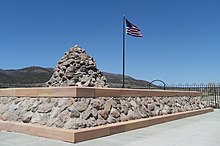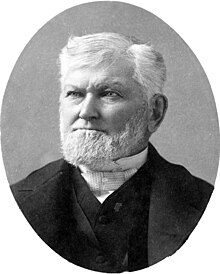Portal:LDS Church: Difference between revisions
added Did you know section |
mNo edit summary |
||
| Line 2: | Line 2: | ||
---- |
---- |
||
{{religion browsebar}} |
{{religion browsebar}} |
||
{{Portal description}} |
|||
<div style="padding: 3px; text-align: center; font-size:1o0%; line-height:170%;"><small>[[Portal:LDS Church|English]]: [[Google Translation]]: [https://translate.google.co.uk/translate?sl=auto&tl=es&js=y&prev=_t&hl=en&ie=UTF-8&u=https%3A%2F%2Fen.wikipedia.org%2Fwiki%2FPortal%3ALDS_Church&edit-text= Spanish], [https://translate.google.co.uk/translate?sl=en&tl=ru&js=y&prev=_t&hl=en&ie=UTF-8&u=https%3A%2F%2Fen.wikipedia.org%2Fwiki%2FPortal%3ALDS_Church&edit-text= Russian], [https://translate.google.co.uk/translate?sl=en&tl=zh-CN&js=y&prev=_t&hl=en&ie=UTF-8&u=https%3A%2F%2Fen.wikipedia.org%2Fwiki%2FPortal%3ALDS_Church&edit-text= Chinese (simplified)], [https://translate.google.co.uk/translate?sl=en&tl=eo&js=y&prev=_t&hl=en&ie=UTF-8&u=https%3A%2F%2Fen.wikipedia.org%2Fwiki%2FPortal%3ALDS_Church&edit-text= Esperanto], [https://translate.google.co.uk/translate?sl=en&tl=iw&js=y&prev=_t&hl=en&ie=UTF-8&u=https%3A%2F%2Fen.wikipedia.org%2Fwiki%2FPortal%3ALDS_Church&edit-text= Hebrew], [https://translate.google.co.uk/?hl=en&tab=wT#en/iw/https%3A%2F%2Fen.wikipedia.org%2Fwiki%2FPortal%3ALDS_Church All languages] |
<div style="padding: 3px; text-align: center; font-size:1o0%; line-height:170%;"><small>[[Portal:LDS Church|English]]: [[Google Translation]]: [https://translate.google.co.uk/translate?sl=auto&tl=es&js=y&prev=_t&hl=en&ie=UTF-8&u=https%3A%2F%2Fen.wikipedia.org%2Fwiki%2FPortal%3ALDS_Church&edit-text= Spanish], [https://translate.google.co.uk/translate?sl=en&tl=ru&js=y&prev=_t&hl=en&ie=UTF-8&u=https%3A%2F%2Fen.wikipedia.org%2Fwiki%2FPortal%3ALDS_Church&edit-text= Russian], [https://translate.google.co.uk/translate?sl=en&tl=zh-CN&js=y&prev=_t&hl=en&ie=UTF-8&u=https%3A%2F%2Fen.wikipedia.org%2Fwiki%2FPortal%3ALDS_Church&edit-text= Chinese (simplified)], [https://translate.google.co.uk/translate?sl=en&tl=eo&js=y&prev=_t&hl=en&ie=UTF-8&u=https%3A%2F%2Fen.wikipedia.org%2Fwiki%2FPortal%3ALDS_Church&edit-text= Esperanto], [https://translate.google.co.uk/translate?sl=en&tl=iw&js=y&prev=_t&hl=en&ie=UTF-8&u=https%3A%2F%2Fen.wikipedia.org%2Fwiki%2FPortal%3ALDS_Church&edit-text= Hebrew], [https://translate.google.co.uk/?hl=en&tab=wT#en/iw/https%3A%2F%2Fen.wikipedia.org%2Fwiki%2FPortal%3ALDS_Church All languages] |
||
</small></div> |
</small></div> |
||
Revision as of 16:49, 4 June 2018
- For a topic outline on this subject, see Outline of The Church of Jesus Christ of Latter-day Saints
The Church of Jesus Christ of Latter-day Saints Portal
The Church of Jesus Christ of Latter-day Saints, informally known as the LDS Church or Mormon Church, is the largest Latter Day Saint denomination, tracing its roots to its founding by Joseph Smith during the Second Great Awakening. The church is headquartered in Salt Lake City, Utah, United States, and has established congregations and built temples worldwide. According to the church, as of 2023, it has over 17.2 million members of which over 6.8 million live in the U.S. The church also reports over 99,000 volunteer missionaries and 350 temples. The church was founded as the Church of Christ in western New York, in 1830 by Smith. Under his leadership, the church's headquarters moved successively to Ohio, Missouri, and Illinois. After Smith's 1844 death and a resultant succession crisis, the majority of his followers sided with Brigham Young, who led the church to its current headquarters in Salt Lake City. Young and his successors continued the church's growth, first throughout the Intermountain West, and more recently as a national and international organization. The church has been criticized throughout its history. Modern criticism includes disputes over the church's historical claims, treatment of minorities, and finances. The church's practice of polygamy was controversial until it was curtailed in 1890 and officially rescinded in 1904. Church theology is restorationist and nontrinitarian; the church strongly identifies as Christian including a belief in the doctrine of salvation through Jesus Christ and his substitutionary atonement on behalf of mankind. It is often included in the lists of larger Christian denominations, though some Catholics, Mainline Protestants and Evangelicals have considered the church to be distinct and separate from mainstream Christianity. The church has an open canon of four scriptural texts: the Holy Bible, the Book of Mormon, the Doctrine and Covenants (D&C), and the Pearl of Great Price. Other than the Bible, the majority of the church canon consists of material the church's members believe to have been revealed by God to Joseph Smith, including texts described as lost parts of the Bible, and other works believed to be written by ancient prophets, including the Book of Mormon. Members adhere to church laws of sexual purity, health, fasting, and Sabbath observance, and contribute ten percent of their income to the church in tithing. The church teaches ordinances through which adherents make covenants with God, including baptism, confirmation, the sacrament, priesthood ordination, endowment and celestial marriage. Members of the church, known as Latter-day Saints or informally as Mormons, believe that the church president is a modern-day "prophet, seer, and revelator" and that Jesus Christ, under the direction of God the Father, leads the church by revealing his will and delegating his priesthood keys to its president. The president heads a hierarchical structure descending from areas to stakes and wards. The church has a volunteer clergy at the local and regional levels; wards are led by bishops. Male members may be ordained to the priesthood, provided they are living the standards of the church. Women are not ordained to the priesthood but occupy leadership roles in some church organizations. Both men and women may serve as missionaries. The church maintains a large missionary program that proselytizes and conducts humanitarian services worldwide. The church also funds and participates in humanitarian projects independent of its missionary efforts. (Full article...) Selected articleThe Pearl of Great Price is part of the canonical Standard Works of the Church of Jesus Christ of Latter-day Saints (LDS Church) and some other Latter Day Saint denominations. The first paragraph of the Introductory Note in the LDS Church edition of the Pearl of Great Price states: "The Pearl of Great Price is a selection of choice materials touching many significant aspects of the faith and doctrine of The Church of Jesus Christ of Latter-day Saints. These items were produced by Joseph Smith and were published in the Church periodicals of his day." The name of the book is derived from the Parable of the Pearl told by Jesus in Matthew 13. (Full article...) Selected image Selected historyThe Mountain Meadows Massacre (September 7–11, 1857) was a series of attacks during the Utah War that resulted in the mass murder of at least 120 members of the Baker–Fancher emigrant wagon train. The massacre occurred in the southern Utah Territory at Mountain Meadows, and was perpetrated by settlers from the Church of Jesus Christ of Latter-day Saints (LDS Church) involved with the Utah Territorial Militia (officially called the Nauvoo Legion) who recruited and were aided by some Southern Paiute Native Americans. The wagon train, made up mostly of families from Arkansas, was bound for California, traveling on the Old Spanish Trail that passed through the Territory. After arriving in Salt Lake City, the Baker–Fancher party made their way south along the Mormon Road, eventually stopping to rest at Mountain Meadows. As the party was traveling west there were rumors about the party's behavior towards Mormon settlers and war hysteria towards outsiders was rampant as a result of a military expedition dispatched by President Buchanan, and Territorial Governor Brigham Young's declaration of martial law in response. While the emigrants were camped at the meadow, local militia leaders, including Isaac C. Haight and John D. Lee, made plans to attack the wagon train. The leaders of the militia, wanting to give the impression of tribal hostilities, persuaded Southern Paiutes to join with a larger party of militiamen disguised as Native Americans in an attack. During the militia's first assault on the wagon train, the emigrants fought back, and a five-day siege ensued. Eventually, fear spread among the militia's leaders that some emigrants had caught sight of the white men, likely discerning the actual identity of a majority of the attackers. As a result, militia commander William H. Dame ordered his forces to kill the emigrants. By this time, the emigrants were running low on water and provisions, and allowed some members of the militia – who approached under a white flag – to enter their camp. The militia members assured the emigrants they were protected, and after handing over their weapons, the emigrants were escorted away from their defensive position. After walking a distance from the camp, the militiamen, with the help of auxiliary forces hiding nearby, attacked the emigrants. The perpetrators killed all the adults and older children in the group, in the end sparing only seventeen young children under the age of seven. Following the massacre, the perpetrators buried some of the remains but ultimately left most of the bodies exposed to wild animals and the climate. Local families took in the surviving children, with many of the victims' possessions and remaining livestock being auctioned off. Investigations, which were interrupted by the American Civil War, resulted in nine indictments in 1874. Of the men who were indicted, only John D. Lee was tried in a court of law. After two trials in the Utah Territory, Lee was convicted by a jury, sentenced to death, and executed by firing squad on March 23, 1877. (Full article...) Selected LocationThe Los Angeles California Temple (formerly the Los Angeles Temple), the tenth operating and the second-largest temple operated by the Church of Jesus Christ of Latter-day Saints (LDS Church), is on Santa Monica Boulevard in the Westwood district of Los Angeles, California, United States. When it was dedicated in 1956, it was the largest of the church's temples, though it has since been surpassed by the Salt Lake Temple due to later expansions. The temple serves 39 stakes in Los Angeles, Ventura, Kern, Santa Barbara, and San Luis Obispo counties. The grounds include a visitors' center, which was renovated in 2010, the Los Angeles Regional Family History Center, both of which are open to the public, and the headquarters of the church's California Los Angeles Mission. (Full article...) Did you know?
Selected biographyWilford Woodruff Sr. (March 1, 1807 – September 2, 1898) was an American religious leader who served as the fourth president of the Church of Jesus Christ of Latter-day Saints (LDS Church) from 1889 until his death. He ended the public practice of plural marriage among members of the LDS Church in 1890. Woodruff joined the Latter Day Saint church after studying Restorationism as a young adult. He met Joseph Smith, founder of the Latter Day Saint movement in Kirtland, Ohio, before joining Zion's Camp in April 1834. He stayed in Missouri as a missionary, preaching in Arkansas and Tennessee before returning to Kirtland. He married his first wife, Phebe, that year and served a mission in New England. Smith called Woodruff to be a member of the Quorum of the Twelve Apostles in July 1838, and he was ordained in April 1839. Woodruff served a mission in England from August 1839 until April 1841, leading converts from England to Nauvoo. Woodruff was away promoting Smith's presidential campaign at the time of Smith's death. After returning to Nauvoo, he and Phebe traveled to England, where Woodruff preached and supported local members. The Woodruffs returned to the United States just before the Saints were driven out of Nauvoo, and Woodruff oversaw forty families in Winter Quarters, where he was sealed to his first plural wives. He joined the advance company that traveled to the Salt Lake Valley without his family in 1847. After returning to Winter Quarters, Woodruff and Phebe left to preside over the Eastern States Mission. Woodruff and his family arrived in Salt Lake City on October 15, 1850. He served in the Utah territorial legislature and was heavily involved in the social and economic life of his community. He worked as an Assistant Church Historian and as Church Historian from 1856 to 1889. He was married to three more wives between 1852 and 1853. In 1877, he became president of the St. George Temple, where endowment ordinances were first performed for the dead as well as the living. Woodruff helped standardize the temple ceremony and decreed that church members could act as proxy for anyone they could identify by name. He also ended sealings of members to unrelated priesthood holders. In 1882, Woodruff went into hiding to avoid arrest for unlawful cohabitation under the Edmunds Act. In 1889, Woodruff became the fourth president of the LDS Church. After government disenfranchisement of polygamists and women in Utah Territory and seizure of church properties, which threatened to extend to temples, Woodruff ended the church's official support of new polygamous marriages in the 1890 Manifesto. Woodruff died in 1898 and his detailed journals provide an important record of Latter Day Saint history. (Full article...) Selected Anniversaries
Selected Quotes
CategoriesRelated portalsLDS Church topicsHistory of The Church of Jesus Christ of Latter-day Saints: Extermination Order - Mormon handcart pioneers - Mormon Battalion - Succession crisis - Mormon Reformation - Mountain Meadows massacre Standard Works: Old Testament - New Testament - Book of Mormon - Doctrine and Covenants - Pearl of Great Price Things you can doWikiProjectsAssociated WikimediaThe following Wikimedia Foundation sister projects provide more on this subject:
|
















